University Report: Leading and Managing Virtual Teams - MGMT 401
VerifiedAdded on 2021/04/21
|5
|1163
|49
Report
AI Summary
This report, addressed in a memo format, examines the critical aspects of leading and managing virtual teams in a modern, globalized business environment. It begins by defining virtual teams and their reliance on communication technologies across diverse geographical locations. The report then delves into the advantages of virtual teams, such as cost-effectiveness, flexibility, access to global talent, and increased innovation. Conversely, it acknowledges the disadvantages, including communication challenges, the impact of poor leadership and management, and the importance of recruiting the right team members. The report provides recommendations for effective virtual team management and concludes by highlighting the potential benefits for organizations, especially startups and small businesses. References to academic sources support the analysis, providing a well-rounded perspective on the topic.
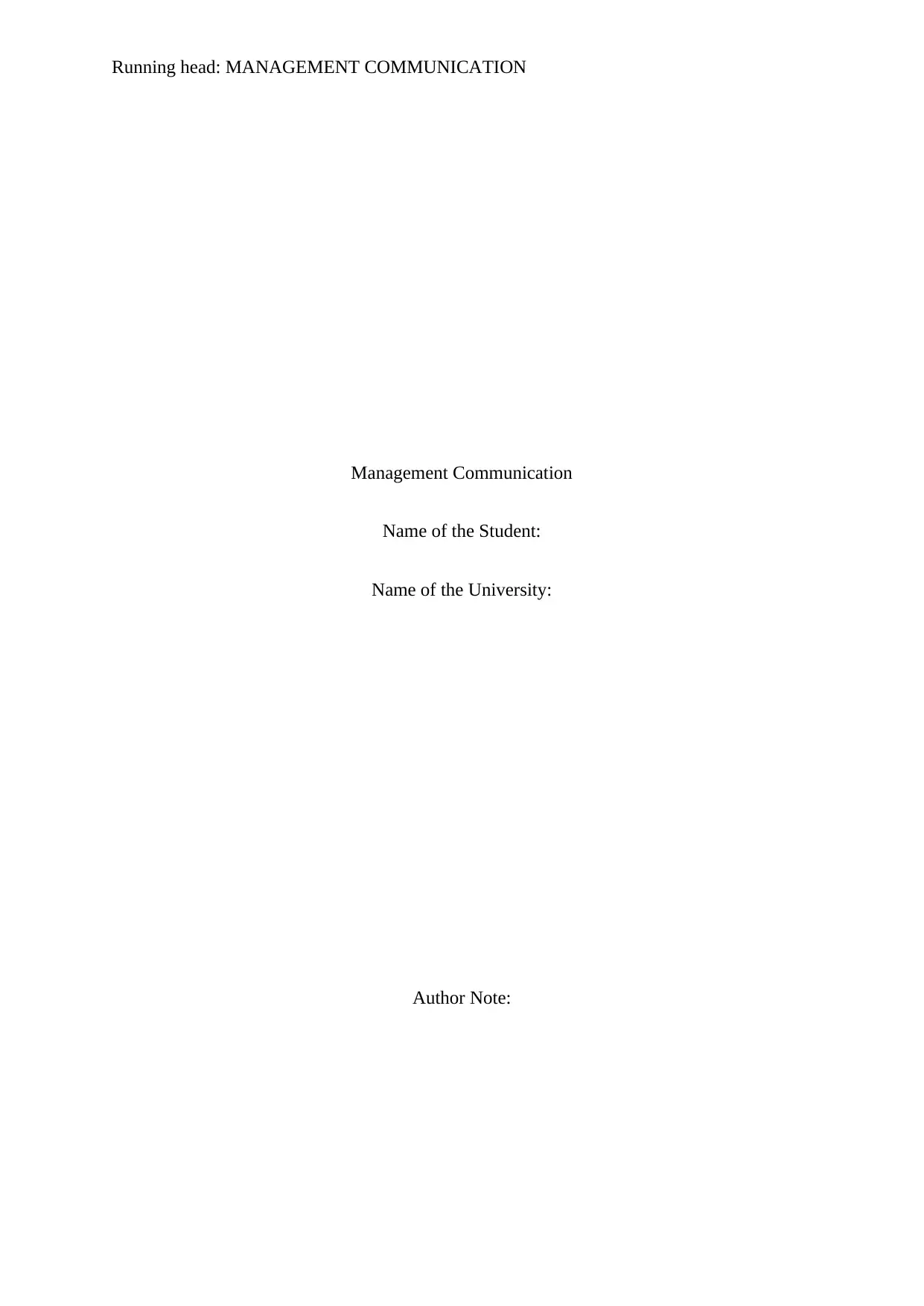
Running head: MANAGEMENT COMMUNICATION
Management Communication
Name of the Student:
Name of the University:
Author Note:
Management Communication
Name of the Student:
Name of the University:
Author Note:
Paraphrase This Document
Need a fresh take? Get an instant paraphrase of this document with our AI Paraphraser
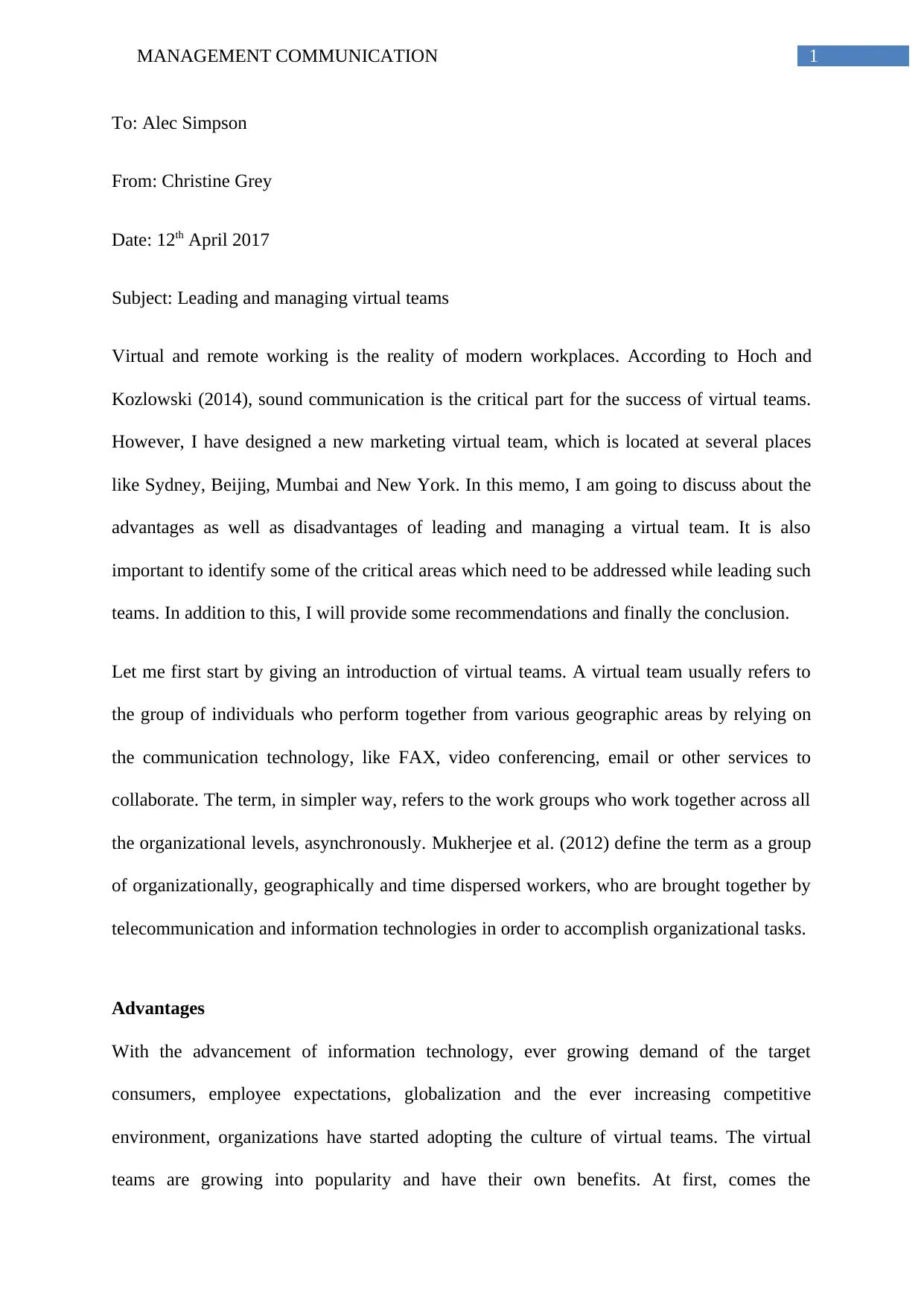
1MANAGEMENT COMMUNICATION
To: Alec Simpson
From: Christine Grey
Date: 12th April 2017
Subject: Leading and managing virtual teams
Virtual and remote working is the reality of modern workplaces. According to Hoch and
Kozlowski (2014), sound communication is the critical part for the success of virtual teams.
However, I have designed a new marketing virtual team, which is located at several places
like Sydney, Beijing, Mumbai and New York. In this memo, I am going to discuss about the
advantages as well as disadvantages of leading and managing a virtual team. It is also
important to identify some of the critical areas which need to be addressed while leading such
teams. In addition to this, I will provide some recommendations and finally the conclusion.
Let me first start by giving an introduction of virtual teams. A virtual team usually refers to
the group of individuals who perform together from various geographic areas by relying on
the communication technology, like FAX, video conferencing, email or other services to
collaborate. The term, in simpler way, refers to the work groups who work together across all
the organizational levels, asynchronously. Mukherjee et al. (2012) define the term as a group
of organizationally, geographically and time dispersed workers, who are brought together by
telecommunication and information technologies in order to accomplish organizational tasks.
Advantages
With the advancement of information technology, ever growing demand of the target
consumers, employee expectations, globalization and the ever increasing competitive
environment, organizations have started adopting the culture of virtual teams. The virtual
teams are growing into popularity and have their own benefits. At first, comes the
To: Alec Simpson
From: Christine Grey
Date: 12th April 2017
Subject: Leading and managing virtual teams
Virtual and remote working is the reality of modern workplaces. According to Hoch and
Kozlowski (2014), sound communication is the critical part for the success of virtual teams.
However, I have designed a new marketing virtual team, which is located at several places
like Sydney, Beijing, Mumbai and New York. In this memo, I am going to discuss about the
advantages as well as disadvantages of leading and managing a virtual team. It is also
important to identify some of the critical areas which need to be addressed while leading such
teams. In addition to this, I will provide some recommendations and finally the conclusion.
Let me first start by giving an introduction of virtual teams. A virtual team usually refers to
the group of individuals who perform together from various geographic areas by relying on
the communication technology, like FAX, video conferencing, email or other services to
collaborate. The term, in simpler way, refers to the work groups who work together across all
the organizational levels, asynchronously. Mukherjee et al. (2012) define the term as a group
of organizationally, geographically and time dispersed workers, who are brought together by
telecommunication and information technologies in order to accomplish organizational tasks.
Advantages
With the advancement of information technology, ever growing demand of the target
consumers, employee expectations, globalization and the ever increasing competitive
environment, organizations have started adopting the culture of virtual teams. The virtual
teams are growing into popularity and have their own benefits. At first, comes the
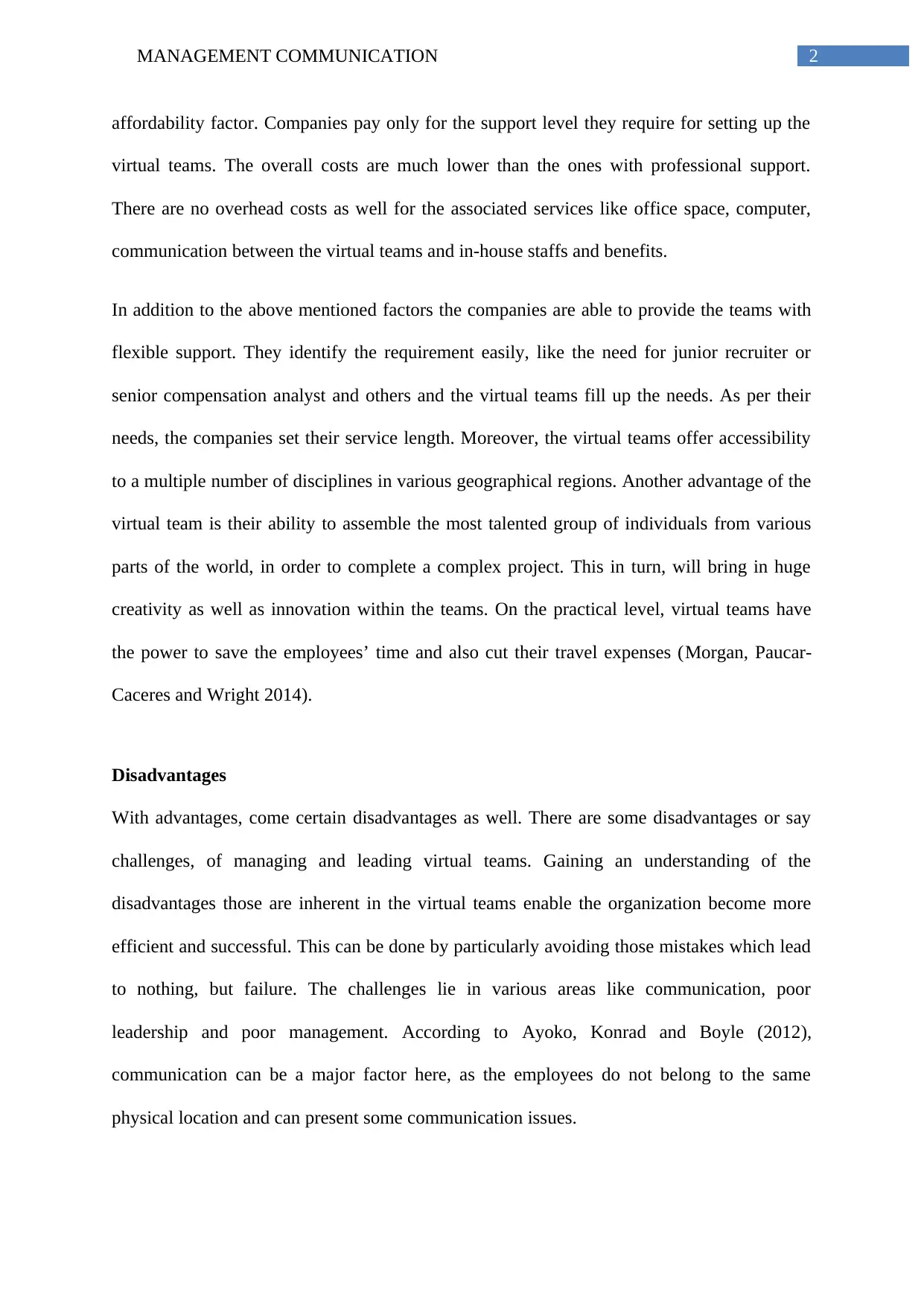
2MANAGEMENT COMMUNICATION
affordability factor. Companies pay only for the support level they require for setting up the
virtual teams. The overall costs are much lower than the ones with professional support.
There are no overhead costs as well for the associated services like office space, computer,
communication between the virtual teams and in-house staffs and benefits.
In addition to the above mentioned factors the companies are able to provide the teams with
flexible support. They identify the requirement easily, like the need for junior recruiter or
senior compensation analyst and others and the virtual teams fill up the needs. As per their
needs, the companies set their service length. Moreover, the virtual teams offer accessibility
to a multiple number of disciplines in various geographical regions. Another advantage of the
virtual team is their ability to assemble the most talented group of individuals from various
parts of the world, in order to complete a complex project. This in turn, will bring in huge
creativity as well as innovation within the teams. On the practical level, virtual teams have
the power to save the employees’ time and also cut their travel expenses (Morgan, Paucar-
Caceres and Wright 2014).
Disadvantages
With advantages, come certain disadvantages as well. There are some disadvantages or say
challenges, of managing and leading virtual teams. Gaining an understanding of the
disadvantages those are inherent in the virtual teams enable the organization become more
efficient and successful. This can be done by particularly avoiding those mistakes which lead
to nothing, but failure. The challenges lie in various areas like communication, poor
leadership and poor management. According to Ayoko, Konrad and Boyle (2012),
communication can be a major factor here, as the employees do not belong to the same
physical location and can present some communication issues.
affordability factor. Companies pay only for the support level they require for setting up the
virtual teams. The overall costs are much lower than the ones with professional support.
There are no overhead costs as well for the associated services like office space, computer,
communication between the virtual teams and in-house staffs and benefits.
In addition to the above mentioned factors the companies are able to provide the teams with
flexible support. They identify the requirement easily, like the need for junior recruiter or
senior compensation analyst and others and the virtual teams fill up the needs. As per their
needs, the companies set their service length. Moreover, the virtual teams offer accessibility
to a multiple number of disciplines in various geographical regions. Another advantage of the
virtual team is their ability to assemble the most talented group of individuals from various
parts of the world, in order to complete a complex project. This in turn, will bring in huge
creativity as well as innovation within the teams. On the practical level, virtual teams have
the power to save the employees’ time and also cut their travel expenses (Morgan, Paucar-
Caceres and Wright 2014).
Disadvantages
With advantages, come certain disadvantages as well. There are some disadvantages or say
challenges, of managing and leading virtual teams. Gaining an understanding of the
disadvantages those are inherent in the virtual teams enable the organization become more
efficient and successful. This can be done by particularly avoiding those mistakes which lead
to nothing, but failure. The challenges lie in various areas like communication, poor
leadership and poor management. According to Ayoko, Konrad and Boyle (2012),
communication can be a major factor here, as the employees do not belong to the same
physical location and can present some communication issues.
⊘ This is a preview!⊘
Do you want full access?
Subscribe today to unlock all pages.

Trusted by 1+ million students worldwide
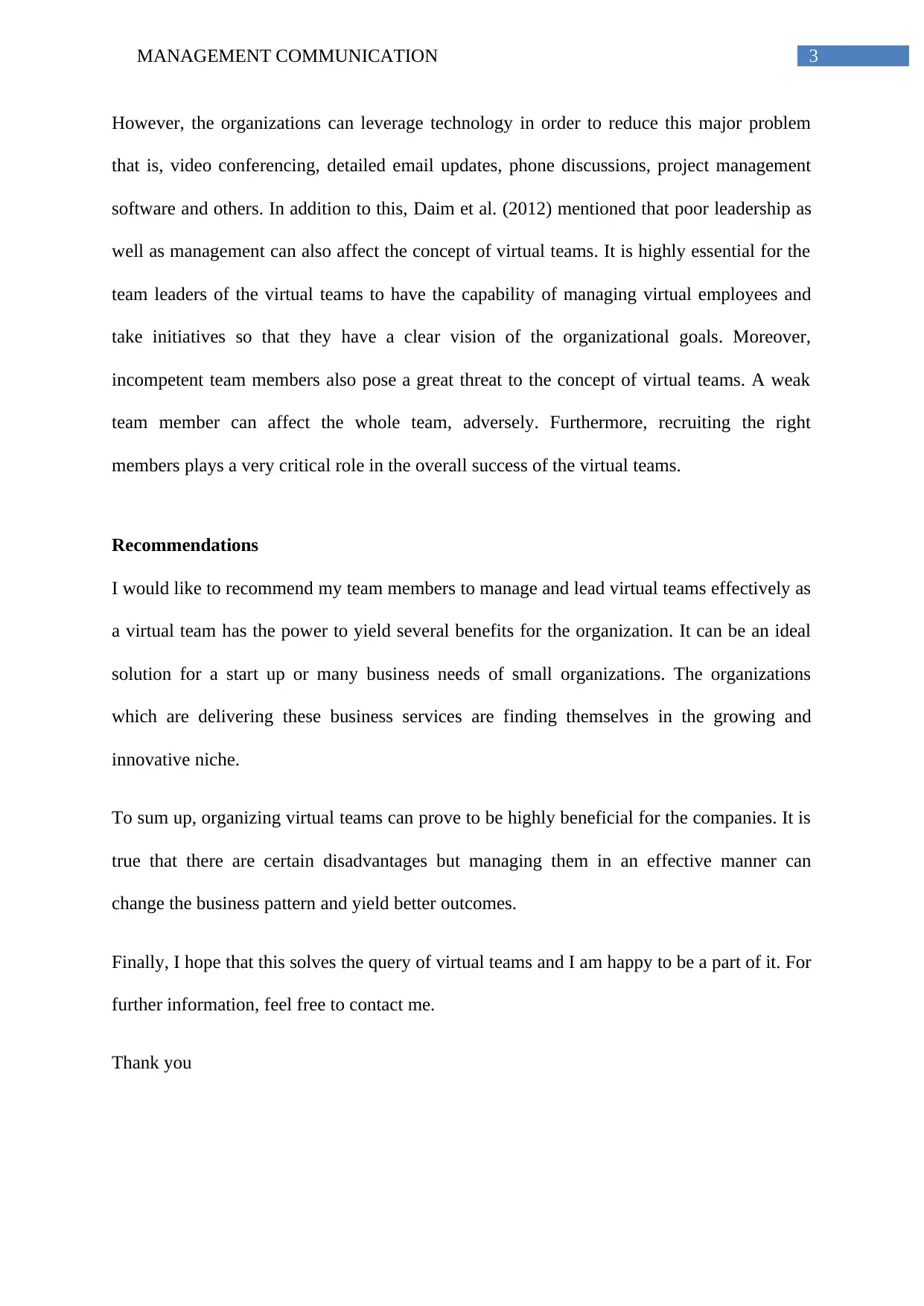
3MANAGEMENT COMMUNICATION
However, the organizations can leverage technology in order to reduce this major problem
that is, video conferencing, detailed email updates, phone discussions, project management
software and others. In addition to this, Daim et al. (2012) mentioned that poor leadership as
well as management can also affect the concept of virtual teams. It is highly essential for the
team leaders of the virtual teams to have the capability of managing virtual employees and
take initiatives so that they have a clear vision of the organizational goals. Moreover,
incompetent team members also pose a great threat to the concept of virtual teams. A weak
team member can affect the whole team, adversely. Furthermore, recruiting the right
members plays a very critical role in the overall success of the virtual teams.
Recommendations
I would like to recommend my team members to manage and lead virtual teams effectively as
a virtual team has the power to yield several benefits for the organization. It can be an ideal
solution for a start up or many business needs of small organizations. The organizations
which are delivering these business services are finding themselves in the growing and
innovative niche.
To sum up, organizing virtual teams can prove to be highly beneficial for the companies. It is
true that there are certain disadvantages but managing them in an effective manner can
change the business pattern and yield better outcomes.
Finally, I hope that this solves the query of virtual teams and I am happy to be a part of it. For
further information, feel free to contact me.
Thank you
However, the organizations can leverage technology in order to reduce this major problem
that is, video conferencing, detailed email updates, phone discussions, project management
software and others. In addition to this, Daim et al. (2012) mentioned that poor leadership as
well as management can also affect the concept of virtual teams. It is highly essential for the
team leaders of the virtual teams to have the capability of managing virtual employees and
take initiatives so that they have a clear vision of the organizational goals. Moreover,
incompetent team members also pose a great threat to the concept of virtual teams. A weak
team member can affect the whole team, adversely. Furthermore, recruiting the right
members plays a very critical role in the overall success of the virtual teams.
Recommendations
I would like to recommend my team members to manage and lead virtual teams effectively as
a virtual team has the power to yield several benefits for the organization. It can be an ideal
solution for a start up or many business needs of small organizations. The organizations
which are delivering these business services are finding themselves in the growing and
innovative niche.
To sum up, organizing virtual teams can prove to be highly beneficial for the companies. It is
true that there are certain disadvantages but managing them in an effective manner can
change the business pattern and yield better outcomes.
Finally, I hope that this solves the query of virtual teams and I am happy to be a part of it. For
further information, feel free to contact me.
Thank you
Paraphrase This Document
Need a fresh take? Get an instant paraphrase of this document with our AI Paraphraser
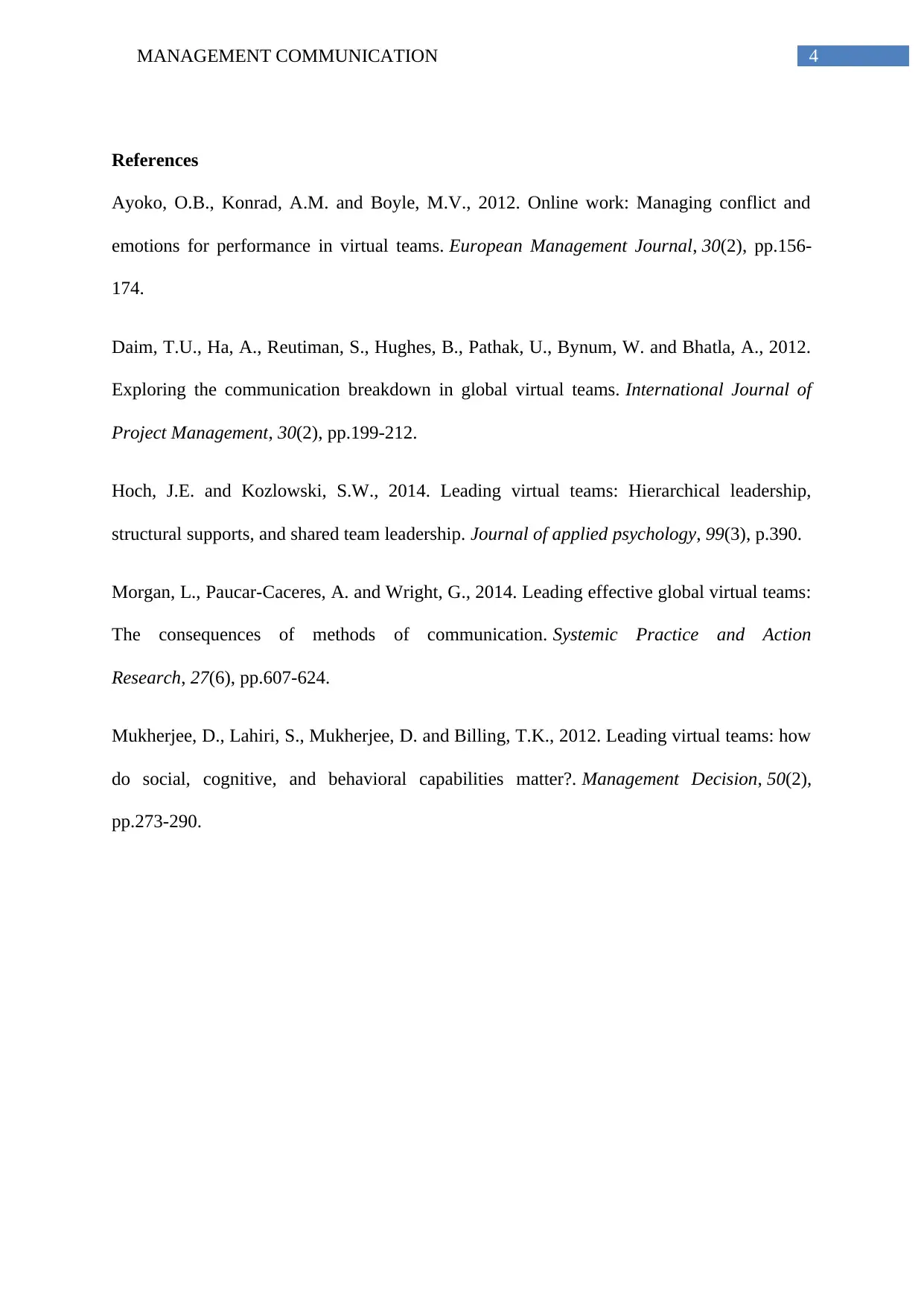
4MANAGEMENT COMMUNICATION
References
Ayoko, O.B., Konrad, A.M. and Boyle, M.V., 2012. Online work: Managing conflict and
emotions for performance in virtual teams. European Management Journal, 30(2), pp.156-
174.
Daim, T.U., Ha, A., Reutiman, S., Hughes, B., Pathak, U., Bynum, W. and Bhatla, A., 2012.
Exploring the communication breakdown in global virtual teams. International Journal of
Project Management, 30(2), pp.199-212.
Hoch, J.E. and Kozlowski, S.W., 2014. Leading virtual teams: Hierarchical leadership,
structural supports, and shared team leadership. Journal of applied psychology, 99(3), p.390.
Morgan, L., Paucar-Caceres, A. and Wright, G., 2014. Leading effective global virtual teams:
The consequences of methods of communication. Systemic Practice and Action
Research, 27(6), pp.607-624.
Mukherjee, D., Lahiri, S., Mukherjee, D. and Billing, T.K., 2012. Leading virtual teams: how
do social, cognitive, and behavioral capabilities matter?. Management Decision, 50(2),
pp.273-290.
References
Ayoko, O.B., Konrad, A.M. and Boyle, M.V., 2012. Online work: Managing conflict and
emotions for performance in virtual teams. European Management Journal, 30(2), pp.156-
174.
Daim, T.U., Ha, A., Reutiman, S., Hughes, B., Pathak, U., Bynum, W. and Bhatla, A., 2012.
Exploring the communication breakdown in global virtual teams. International Journal of
Project Management, 30(2), pp.199-212.
Hoch, J.E. and Kozlowski, S.W., 2014. Leading virtual teams: Hierarchical leadership,
structural supports, and shared team leadership. Journal of applied psychology, 99(3), p.390.
Morgan, L., Paucar-Caceres, A. and Wright, G., 2014. Leading effective global virtual teams:
The consequences of methods of communication. Systemic Practice and Action
Research, 27(6), pp.607-624.
Mukherjee, D., Lahiri, S., Mukherjee, D. and Billing, T.K., 2012. Leading virtual teams: how
do social, cognitive, and behavioral capabilities matter?. Management Decision, 50(2),
pp.273-290.
1 out of 5
Related Documents
Your All-in-One AI-Powered Toolkit for Academic Success.
+13062052269
info@desklib.com
Available 24*7 on WhatsApp / Email
![[object Object]](/_next/static/media/star-bottom.7253800d.svg)
Unlock your academic potential
Copyright © 2020–2025 A2Z Services. All Rights Reserved. Developed and managed by ZUCOL.





